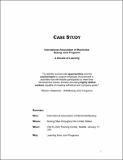CASE STUDY: International Association of Machinists Boeing Joint Programs
Author(s)
Kochan, Thomas A.; Barrett, Betty
Download2001_Kochan,Barrett_ADecadeofLearning.pdf (310.6Kb)
Terms of use
Metadata
Show full item recordAbstract
The paragraph on the title page summarizes the goals of language first inserted in the 1989 collective bargaining agreement between the International Association of Machinists and Aerospace Workers (IAM) and the Boeing Corporation. While the language in the old article called for the company and union to work together to introduce new technology and involve the workforce, in reality not much of this was being done. Nor were there resources available to support such efforts. Moreover, the union leadership was wary of entering into joint programs with the company because its international union had a general distrust of management initiated “quality circles” or other processes that it feared would erode worker rights or drive a wedge between members and their union. Both management and labor leaders, however, recognized the need to introduce and adapt to technological change to keep the company competitive and generate new opportunities. Both agreed that this was a practical and focused area of shared interest where a collaborative effort made sense. The purpose of this brief note is to describe how this joint program has evolved over its first decade of experience. It is not an evaluation or assessment of the program. Instead, we present it here only to illustrate the potential of this type of joint effort for bringing life long learning to hourly workers in a world of continuous technological and organizational change. We end by speculating about how the program might step up to the next level of development and impact.
Date issued
2001Keywords
joint programs, Boeing Corporation, International Association of Machinists and Aerospace Workers, IAM
Collections
The following license files are associated with this item: